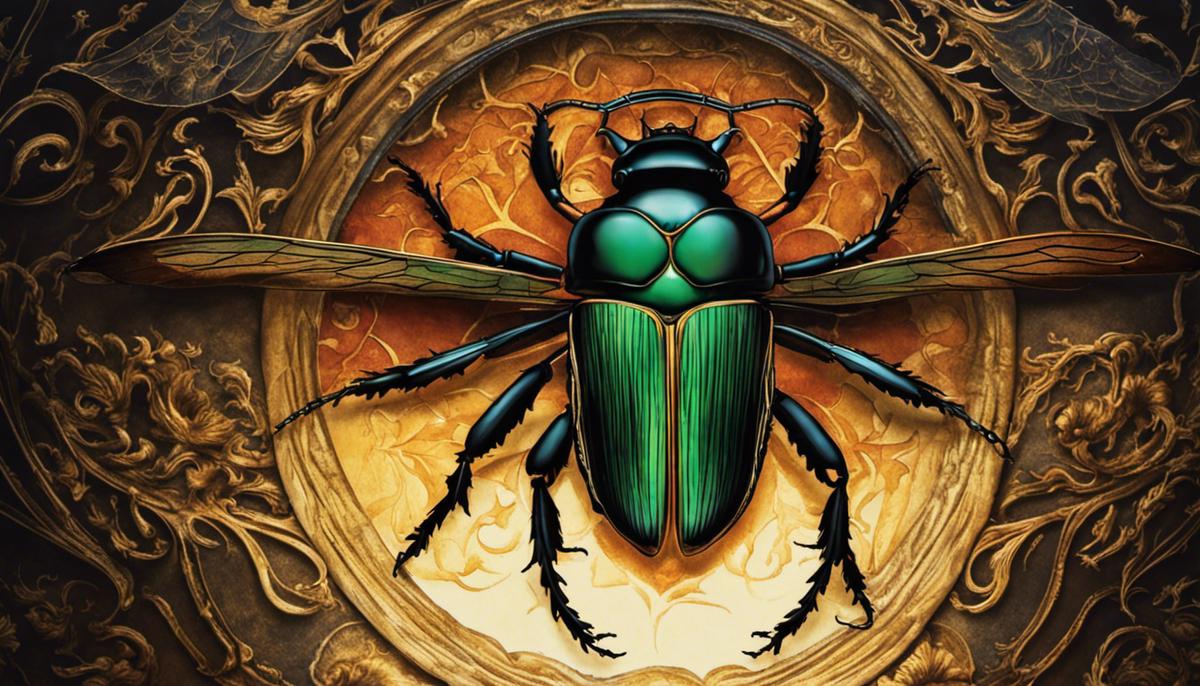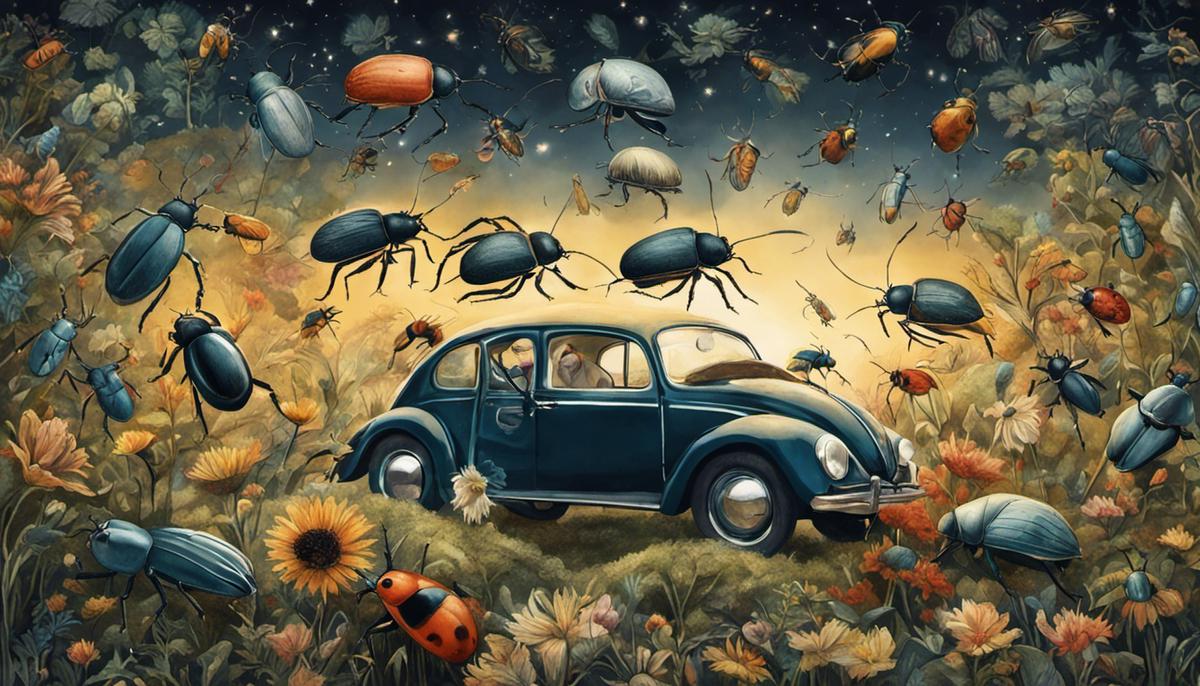Beetles, small yet intricate creatures, can often be overlooked in the grand tapestry of life. These creatures, present since antiquity, have made their way into the annals of history, culture, and even spiritual tradition and now, we are delving into their significance in the realm of dreams. Dreams have always been an enigmatic space, a convergence of personal, theological, psychological, and societal narratives that venture into the human subconscious. Could it be then, that the humble beetle plays a greater role in our psyche? By examining the symbolism of beetles in the scriptures and their portrayal in historical context, exploring dream interpretation from theological and psychological perspectives, understanding their spiritual and psychological significance, and analyzing their appearances in dreams in a biblical sense, this piece offers a holistic approach to dream interpretation specifically involving beetles.
Symbolism of Beetles in Scriptures: Historical Context
The symbolism of beetles in scripture is both intriguing and complex, offering riveting insights into the historical context of many ancient civilizations, particularly those in the Near East and North Africa. The beetle’s appearance in sacred texts provides us with an arresting window into the metaphysical framework of these societies, allowing us to glimpse their spiritual beliefs, cosmological views, and societal mores with a degree of fidelity not afforded by other kinds of archaeological or anthropological evidence.
The scarab beetle holds an eminent position in the canon of Egyptian symbolism. Our studies of hieroglyphic inscriptions reveal that the Egyptians referred to the scarab beetle as Kheper, a homophone for the verb “to become.” This linguistic connection affords us a deeper understanding of the spiritual significance of the beetle in that society.
Ancient Egyptians observed the behavior of the scarab beetle — the way in which it rolled balls of dung across the ground and buried them to serve as a food source for its larvae. This action was interpreted metaphorically: the dung ball embodied the Sun, the ground embodied the cosmos, and the larvae embodied rebirth or resurrection. Consequently, the beetle was seen as a tangible representation of the Sun’s daily journey across the sky and its rebirth at dawn.
This symbolic association was powerful enough to earn the scarab a significant place in the Egyptian pantheon. Khepri, the ancient Egyptian god of the rising sun, was often depicted as a man with the head of a scarab beetle or as a scarab in its entirety. Furthermore, scarab amulets – often inscribed with magical spells and used as seals – were an essential aspect of Egyptian burial rituals, believed to offer the deceased safe passage into the afterlife.
Religious texts from other parts of the ancient Near East also contain references to beetles, though the specific connotations may vary between cultures and historical periods. In the cosmologies of these societies, beetles were commonly seen as representative or emblematic of concepts such as transformation, regeneration, and persistence, reflecting observations of the insect’s life cycle and behavior.
The biblical canon, however, takes a different stance on beetles — although this is dependent on the exact interpretation of the original text. The book of Leviticus, for instance, describes an array of creatures considered unclean by the ancient Hebrews, and in some translations, beetles are listed among these. This highlights the differences in sociocultural context between the Egyptians and the Hebrews, pointing toward an alternate interpretation and valuation of symbolic elements within their respective societies.
In conclusion, the symbolism of beetles in various scriptures has provided us with fascinating insights into diverse historical and cultural contexts. Through these creatures, we glimpse the complex network of beliefs and interpretations that informed the spiritual lives of ancient societies. The beetle — a seemingly humble insect — thus unfolds to us the intricate tapestry of human experience across civilizations and eras, underlining the significance of symbolic analysis in the comprehension of our shared human history.

Dream Interpretation in Theological and Psychological Context
As we traverse further into our exploration of dream interpretations, our path takes us to a junction, where two distinct but intertwined disciplines intersect – theology and psychology. Both fields offer unique, contrasting, although at times overlapping, insights into the elusive realm of dreams.
Theologians dating back from antiquity have long believed dreams to be symbolic messages from divinities, encapsulated in metaphoric narratives. Reflecting this belief, ancient texts reveal numerous instances of dreams wielded as divine mediums. The biblical Joseph’s dreams, for instance, have profound theological interpretations, paving the path of his life while informing the chronicles of a whole civilization. Equally notable are Nebuchadnezzar’s prophetic dreams in the Book of Daniel. Mesopotamian literature too highlights divine dream encounters, archived in iconic tales like that of King Gudea of Lagash.
Challenging this theological perspective, however, Sigmund Freud, in his seminal work, “The Interpretation of Dreams,” revolutionized the sphere by suggesting a markedly different standpoint. Placing dreams in the domain of the subconscious, Freud argued that dreams served to fulfill repressed wishes, harboring deeply personal meanings rather than divine clues. This psychological interpretation of dreams stepped away from the communal, society-oriented view of theology, focusing instead on the individual.
Carl G. Jung, another key figure in the annals of psychology, while accepting aspects of Freud’s theories, brought an enlightening twist to the discourse. Jung postulated that dreams serve as tools for self-introspection through the concept of ‘individuation,’ where one finds personal meaning and understanding in dreams. He introduced notions of archetypes and collective unconscious forming the substrate of dream content, blending psychological insight with a quasi-spiritual mystique.
Often, these interpretations have drawn upon primordial symbols present throughout cultures. The recurring presence of insects in dream analysis, for example, epitomizes the shared realm of these interpretations. Here, the psychological interpretive domain and theological exposition can converge. Psychologists may posit that insects in dreams might symbolize feelings of irritation or insignificance. Conversely, a theologically grounded analysis might correlate insects, such as majestic beetles from Egyptian symbolism, as a representation of resurrection or metamorphosis.
While these disciplines reflect different perspectives, they are by no means mutually exclusive. Current inquiry often marries psychological and theological interpretation techniques. As we navigate the undiscovered terrain within the world of dreams, a collaborative approach can unveil intricate facets of our individual and collective subconscious. Threading together individual narratives with collective influences, a combined theological and psychological perspective affords us an enriched, holistic understanding of dream interpretations.

Spiritual and Psychological Significance of Beetles
Shifting away from the ancient histories and into the realm of the subconscious, the beetle develops deeper meanings and associations particularly in the inner workings of the human mind, and in the significance that we attribute to our most profound dreams. It is suggested by the theologians that dreams serve as a symbolic conduit for communication from the divine. Instances of this perspective can be traced through to several ancient texts, where prophetic dreams encapsulate major plot points. For instance, both Joseph’s and Nebuchadnezzar’s dream narratives have shaped substantial narratives of related texts.
The understanding of dream symbolism is not confined to spiritual beliefs as it managed to seep into the arena of psychology as well, with the works of great contributors such as Freud and Jung. Freud posited that dreams offered a safe space for the expression and fulfillment of repressed wishes. His revolutionary theory opened up the recognition towards the psychological implications of dreams.
However, it is in the work of Carl G. Jung where the beetle finds its place. Jungian psychology suggests that dreams serve as introspective tools that aids in understanding the self. He introduced the concepts of archetypes and the collective unconscious that mediates the inherent human behaviour and perspective on universally significant symbols that define our psyche. The beetle, like other insects, comes under the archetype of transformation in Jungian theory.
Indeed, the convergence of psychological and theological interpretations in the framing of dream symbolism is evident. This nexus represents the evolving approach to understanding these symbols, the beetle included, intertwining psychological processes with spiritual perspectives.
Current inquiries have sought to marry the psychological and theological interpretation techniques, offering a holistic perspective on the theme. Perhaps it is through this convergence that the layers of symbolism of the beetle – from ancient spiritual representation to subconscious dream symbolism –can be fully grasped.
In a broader context, this combined perspective aids in deepening our comprehension of human experiences, encapsulating the tangible and intuitive facets of life. Not only does it reveal the rich significance underlying everyday symbols like the beetle, but it also unearths the immense potential of human psyche in interfacing with the world around us.
In conclusion, the beetle invariably stands as a compelling symbol in both spiritual and psychological realms. It is a testament to the powerful resonance of nature’s creatures in sparking profound reflections among civilizations, apothegms, multitudes of belief systems, and in the recesses of our dreams, ultimately guiding us to comprehend the profound enigma that is the human existence.

Beetles in Dreams: Biblical Analysis
Understanding the symbolism of beetles in dreams from a biblical perspective is a deep and nuanced field of interpretation. It requires an understanding of the complex intertwinements between biblical symbolism, the psychology of dreams, and the beetle’s representation in cultures across the globe. To meaningfully interpret a dream about beetles from a biblical perspective, we must first examine the beetle’s role within biblical scriptures.
In the Judeo-Christian tradition, the beetle isn’t frequently exhibited; hence, its significance is largely extrapolated from the roles insects, in general, play within the Holy Writ. Typically, they are portrayed as instruments of divine punishment or omens of societal and moral decay, as evidenced in the plagues inflicted upon Egypt in the Book of Exodus. However, insects also symbolize rebirth and regeneration, paralleling their natural life stages of metamorphosis.
Analyzing biblical dream interpretation necessitates a look at early Christian scholars including Tertullian, Origen, and St. Augustine, who viewed dreams as direct divine messages or predictive prophecies. Drawing parallels to the prophecies experienced by Joseph and Nebuchadnezzar, dreaming of beetles may be interpreted as divine guideposts alerting the dreamer to an impending transformation, rebirth, or change in their life.
Venturing into psychoanalytical interpretations of dreams, Freudian and Jungian theories offer an alternate, albeit equally compelling viewpoint. Freud believed dreams were expressions of our repressed desires, an unconscious wish fulfillment. From that perspective, a dream about beetles may point to suppressed feelings or desires that are seeking manifestation.
Jung, on the other hand, viewed dreams as compensatory messages from the collective unconscious, a rectification of our conscious attitudes. Within his archetypal system, the beetle may serve as an archetype of transformation. The beetle’s process of metamorphosis – from larvae to pupa to adult – mirrors the human journey of evolution and self-actualization, a process that Jung believed was enacted through our dreams.
Having considered both the theological and psychoanalytical perspectives, it’s evident that both approaches complement and enrich each other. Individually, they offer insightful interpretations, but when married, these perspectives can yield a more profound understanding of our dream world. This union allows for a comprehensive inquiry into the human psyche and experience.
Insects, including beetles, in dreams act as gateways to profoundly reflective and transformative states within our subconscious mind. They trigger response from deep-seated memories and provoke rich emotional reactions, contributing an invaluable cog to the complex machinery of dream interpretation. By bridging these perspectives—ancient and modern, spiritual and psychological, symbolic and literal—we pave the way for a more profound understanding of our dreams and ourselves. Thus, dreaming of beetles directs us toward introspection, symbolizing a journey through transformation and renewal from a biblical perspective. It lends credence to the belief that nature’s creatures are not just biological, but deeply symbolic entities, sparking profound reflections on the enigma of human existence.

Modern Applications and Interpretations
In modern times, biblical interpretations of dreaming about beetles continue to have a significant impact. In the realm of theology, dreams have been esteemed as messages from a higher power. Literary references to this are scattered throughout canonical texts such as the Bible, with evidence in the accounts of patriarchs such as Joseph being bestowed divinely inspired dreams. The remnants of these ancient beliefs are still seen in current times with the common assumption that symbolism in dreams might furnish an understanding of an individual’s fate or destiny.
Biblical references to beetles, specifically in the books of Leviticus, communicate the notion of prophecy and divine judgment. Here, beetles are portrayed as harbingers of retribution, driving home the Judeo-Christian understanding of divine justice. This theological perspective brings to light the potential spiritual symbolism embedded in dreams about beetles as possibly representing corrective actions to take, or changes due in one’s life.
Further, extending the discussion into the realm of psychodynamics, revolutionary scientific minds like Sigmund Freud and Carl Jung offered new understandings. Freud suggested dreams as a pathway to one’s repressed wishes, while Jung posited them as gateways to self-understanding and the complexities of the collective unconscious. The beetle, considered an archetype in Jungian theory, embodies transformation; thus, dreams about beetles can be seen as signalling pivotal change and self-discovery.
Considering the beetle’s biblical role as a divine instrument and its psychological representation as a signal of transformation, it becomes apparent how these perspectives can intertwine in modern context. Leveraging the synthesis of these fields, we can approach dream interpretation from a holistically insightful perspective, weaving together theological dogmas and analytic psychology.
Moreover, beetles fall within a category of critters that in various cultures trigger deep-running emotions, memories, or primal fear, adding another dimension to the potential interpretation of such dreams. Incorporating beetles in the Dreamer’s psyche could thus be connected to unearthing deeply sedimented emotional states needing attention.
In a time when spiritualism is increasingly converging with scientific inquiry, it is stimulating to consider how symbols as ancient and ubiquitous as beetles find their place. Indeed, reconciling tradition with contemporaneity, spiritual with psychological approaches, symbolic with tangible perspectives, we see how the symbolism of the beetle marries the ancient and modern world. Echoes of ancient civilizations are interwoven into our current collective psyche, continuously prompting us to reflect upon the enigmatic nature of our existence.
Dreaming of beetles can thus be seen as a symbol urging introspection and transformation from a biblical perspective. As creatures of nature, beetles embody the profound and at times paradoxical symbolism tied to human existence. By considering biblical interpretations, psychoanalytical insights, and modern perspectives, we see how dreams about beetles can provide an integrative platform for understanding broader human experiences within a contemporary framework.

By engaging with biblical text, psychological theories, and societal interpretations, we journeyed through multiple layers of understanding, uncovering the symbolism of beetles within dreams from various standpoints. Beetles, in their minute yet profound presence within biblical, psychological, and societal interpretations, mirror the complexities of human existence. They serve as a testament to the vast depths of our subconscious, the intricate workings of our psyches, and ultimately, our ceaseless pursuit for meaning. Whether ancient or modern, these interpretations of beetle dream symbolism continue to influence our perspectives and experiences, subtly shaping shared narratives and spawning individual awakenings. These fragile insects continue to flit through the collective unconscious, bridging gaps between the tangible world and the spiritual domain, ultimately embracing their status as emblems of human desire to decipher the enigmatic language of dreams.







